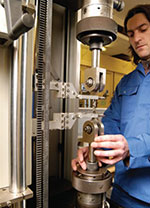IncoTest utilises industry standard methods of chemical analysis. Providing such a wide range of techniques ensures the client that samples are analysed by the most economical method, depending on the type of material, the form of the sample and the level of accuracy required.
IncoTest Laboratories use a number of industry standard techniques for the Chemical Analysis of a wide variety of metal alloys, including Iron, Nickel, Cobalt, Titanium, Copper and Aluminium based materials.
Techniques employed include:
Wavelength Dispersive X-Ray Flourescence Spectrometry
Routine analysis of the major alloying elements in Ferrous and non-Ferrous alloys. The sample must be in a solid form.
Inductively Coupled Plasma Optical Emission Spectrometry
This technique offers an alternative to XRF and conventional OES when sample size is limited or the sample form is unsuitable (e.g. turnings, fine wire or powder). The analysis involves dissolution of the sample, and therefore it is relatively easy to prepare closely matching calibration standards from pure metals and compounds.
This is particularly important where appropriate CRMs are not available or where an independent over check is needed. Analysis includes major and minor alloying elements in ferrous and non-ferrous alloys as well as close range calibration for non-standard materials not covered by other techniques. Sample form is not critical unlike other "physical" testing methods such as XRF.
Spark Source Optical Emission Spectrometry
Minor alloying elements in Ferrous and non-Ferrous materials.
Glow Discharge Mass Spectrometry (GDMS)
GDMS is a trace analysis technique that benefits from minimal sample preparation to minimise loss of volatiles or contamination while utilising the low limits of quantification of high resolution mass spectrometry.
The Sample is held in a reduced pressure inert atmosphere and a high potential voltage is applied. This causes the release of positively charged ions from the surface of the sample in a process known as sputtering. The Sputtered Ions then pass into the mass Spectrometer, which can separate the ions by their mass to charge ratio.
Our GDMS utilises three different detectors allowing it to quantify values from percentage to PPB over a mass range from Lithium to Uranium.
Combustion Analysis (IR Detection) for Carbon and Sulphur
Carbon and Sulphur are determined by RF combustion in oxygen. The resulting carbon dioxide and sulphur dioxide are then measured by infra-red absorption and converted to the elemental concentrations.
Inert Gas Fusion for Hydrogen, Oxygen and Nitrogen
Oxygen, Nitrogen and Hydrogen levels are determined by the Inert Gas Fusion method. The sample is melted under an inert gas stream in a graphite crucible and the gases evolved are measured by thermal conductivity or infra-red absorption.
The instrumentation is calibrated for ferrous, non-ferrous, and titanium alloys in a variety of forms including powders.
